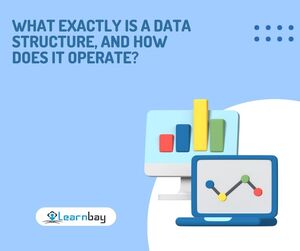What Exactly Is a Data Structure, And How Does It Operate?
Corps
Most people refer to data as computer information, whether it is being stored or transferred. It is also possible to classify information as data if written in numbers or text on paper, stored as bits and bytes in an electronic memory device, or stored in the brain. A collection of data, a set of values, or values of a specific format that correspond to a specific combination of elements are all referred to as data structures.
If you are a beginner in data structures, check out the instructor-led online DSA course, and master them in just a few months.
What is a Data structure?
An effective method of storing, organizing, processing, and retrieving data is using a data structure. Different types of structures are created to organize data for various purposes. Users can now easily access the data they require, thanks to this. Information is arranged in a data structure so that machines and people can understand it. Data structures are created for particular computer science and programming algorithms. Data values, relationships, and functions that can be used on the data are described in each structure.
Data structures: Types and Examples
Different data structures are employed daily to address logical and mathematical issues. One can organize and manage a sizable amount of data in a reasonably quick length of time by using a data structure. Data structures can be divided into two categories: primitive and non-primitive.
-
Primitive
These kinds of data structures function directly, carrying out the commands given to them by the computer. They contain only one value and include data types like float, int, pointers, and double.
-
Non-Primitive
Data structures of this complexity have their roots in simpler ones. Linear and non-linear data structures are the two types:
-
Linear Data Structure
The elements in a linear data structure are constantly connected to their predecessors and successors, and the data is organized linearly or sequentially in this fashion. The linear data structure can be either static, where the data has a set memory size that makes it simple to access the elements, or dynamic, where the memory size is variable and allows for arbitrary modifications to the data.
- Arrays
Items are gathered and kept in close proximity to one another in this linear data structure. The key concept is to group similar data kinds together in one location. This enables the processing of a lot of data in a short period of time.
The actions that can be performed on arrays include searching, inserting, sorting, and removing, among others.
- LinkedList
Element storage is not continuous across memory locations in this linear data structure. A reference or a pointer is used to connect each component in this paragraph. Linked lists are generally categorized as a singly-linked list, doubly-linked list, circular linked list, and doubly circular linked list. The links are kept in extra memory by this data structure.
- Stack
Every action in this linear data structure is carried out in a specific sequence. "Last in is first out" is the order. This is called a push-and-pop procedure since data can only be entered and retrieved from one end. Recursion, sorting, deleting, and various other operations are carried out on a stack.
- Queue
In order to carry out its operations, this linear data structure follows the principle of "first in, first out." Data entry and retrieval are done from several ends, with the data that has been sorted initially being the only data that is accessible at first. The principle of being first in line always applies in a queue for a certain consumer. Here, you must remove all previously added files to view a file.
If you are still not confident about these methods, visit the data structure course and learn everything from the industry experts.
b) Non-Linear Data Structure
The data elements in this second non-primitive data structure are not sequential. It's challenging to navigate everything at once in this situation. These are what they include:
- Tree
With the top node being referred to as the root node, the components in this non-linear data structure are arranged in a tree-like pattern. A variety of unsorted data are contained in each node.
It is composed of sub-nodes, structural nodes, and center nodes. Edges are used to join these nodes together. The various kinds of trees-like include AVL trees, B-trees, Binary trees, and Binary search trees.
- Graph
This has vertices and edges and is a non-linear data structure. It only has a limited number of edges and vertices connecting the nodes. This data format is mostly used to address sophisticated and difficult programming issues. The graph's center is assumed to be the vertex with the lowest eccentricity.
- Hash Table
This data structure holds values that are associated with the same keys. The relationship between the keys makes it effective for lookup. As a result, regardless of the magnitude of the data, it is effective at finding and inserting.
A Guide to Data Structure Selection
Data structures are selected based on the processes and complexity of the application or software being developed. Selecting the most practical data structure and engineering is wise because different data structures offer various solutions.
- Operations
Understanding the operations you want the data structure to accomplish, such as retrieval, deletion, updating, insertion, and traversal, is crucial. What procedure will be executed frequently? What procedure won't be applied at all?
These kinds of inquiries assist in determining whether the data structure satisfies all of your requirements, whether many structures may be combined to do so, and whether the structures will be quick or sluggish to use.
- Complexity
The issue is which data structure will be the most beneficial and effective when it grows large. Any size of the structure or data should be able to be handled by an effective data structure.
- Memory Control
The quantity of data that can be added is capped by static memory data structures, which need a fixed amount of memory upon installation. On the other hand, dynamic data structures provide the user the authority to allocate, release, and reallocate memory while the program is running. Regardless of the structure being utilized, tools like Python and JavaScript handle data allocation for the user.
If you follow these steps carefully, applying data structures for problem solving will be easy for you. On that note, if you want to learn data structures and algorithms from scratch, you can enroll in the best data structures and algorithms course available at Learnbay. Visit the site for more information.









commentaires